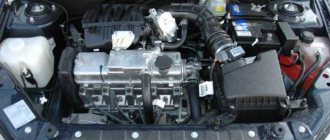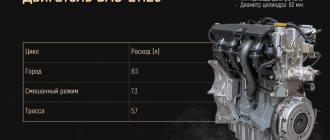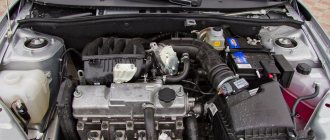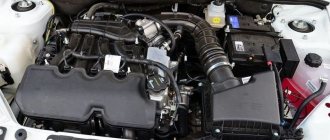Engine VAZ 21127
Years of production - (2013 - present day) Cylinder block material - cast iron Power system - injector Type - in-line Number of cylinders - 4 Valves per cylinder - 4 Piston stroke - 75.6 mm Cylinder diameter - 82 mm Compression ratio - Engine volume - 1596 cm3 . Power – 106 hp. /5800 rpm Torque - 148 Nm / 4000 rpm Fuel - AI95 Fuel consumption - city - | track - | mixed 7 l/100 km Weight of the VAZ 21127 engine -115 kg Oil consumption of the 21127 Priora - 50g/1000km Oil in the Lada 21127 engine: 5W-30 5W-40 10W-40 15W40 How much oil is in the 127 engine: 3.5 l. When replacing, pour 3-3.2 liters.
Resource 21127: 1. According to the plant - 200 thousand km 2. In practice - 200 thousand km
The VAZ-21127 engine is based on the “Prior” 16-valve VAZ-21126 engine, but has the following differences from it:
— maximum power increased to 106 hp. (for VAZ-21126 - 98 hp) - torque increased from 145 to 148 Nm - instead of the mass air flow sensor (MAF), an absolute pressure sensor (MAP) and an air temperature sensor (ATS) were installed ( after abandoning the MAF, The problem of floating idle speed, which many owners of domestic cars suffered from, has practically disappeared
)
Changes in the VAZ-21127 engine
The main change in the VAZ-21127 engine is the appearance of a controlled air intake system. It is a new receiver in which controlled dampers are installed that regulate its volume depending on engine speed. At low speeds, air enters the engine through a long channel, at high speeds through a short channel, which should improve the elasticity of the engine. In essence, this is a conventional inertial supercharging system.
Pros and cons of the VAZ-21127 engine
Pros: - improved engine elasticity - solution to the problem of floating idle speed
Cons: — The cost of transport tax increases sharply, because engine more powerful than 100 hp — If the timing belt breaks, the engine still bends the valves — A car with this engine costs more
Information on engine 21127:
If you know interesting information on this engine, leave links in the comments.
Four-cylinder internal combustion engines of the 126 series are installed on Lada Priora cars and their modifications produced by the famous AvtoVAZ company. The 126 engine belongs to the category of four-stroke engines, is equipped with a distributed fuel injection system, the camshaft is located in the upper part. The power unit is equipped with a liquid cooling system. Coolant circulates inside a closed system under pressure. The functioning of the 21126 motor lubrication system is based on splashing and supplying fluid under pressure.
Technical characteristics of the VAZ 21127 1.6 16kl engine
| Type | in-line |
| Number of cylinders | 4 |
| Number of valves | 16 |
| Exact volume | 1596 cm³ |
| Cylinder diameter | 82 mm |
| Piston stroke | 75.6 mm |
| Supply system | injector |
| Power | 106 hp |
| Torque | 148 Nm |
| Compression ratio | 10.5 — 11 |
| Fuel type | AI-92 |
| Environmental standards | EURO 4 |
Service
The power unit must undergo periodic maintenance every 10 thousand kilometers. Under severe operating conditions, oil and filter changes should be carried out every 7.5 thousand.
When replacing the oil filter, you should pay attention to oil leakage through the valve cover seals. This malfunction is due to the poor quality of the sealing gasket, which leads to contamination of the cooling surfaces and overheating of the motor.
A special feature of the maintenance of this engine is the periodic replacement of hydraulic valve compensators.
When operating a car with this engine, its temperature should be controlled - 95-98 degrees Celsius, otherwise the elements of the cooling system will wear out very quickly. The cause of this is usually the thermostat, which is the weak element in this system.
Removal of the exhaust pipe should be carried out with extreme caution; instead of copper nuts, the manufacturer installed steel ones; if they sour, the mounting brackets can break off. When carrying out this type of work, it is better to immediately replace these nuts with copper ones.
The worst feature of this engine is that when it fails, the engine bends the timing valve, leading to expensive repairs. Tensioning and replacing the timing belt is best done at a service center. The Lada Priora engine has 106 hp. p., according to reviews from owners, high-quality oil should be poured, otherwise the hydraulic valve compensators will fail very quickly.
The engine is also marked by knocking in the elements of the crank mechanism, main and connecting rod bearings, while the engine shakes.
Design features of the Lada 21127 16 valve engine
The donor for the new power unit was the already well-known VAZ 21126 engine. The main difference from its predecessor is the use of a modern intake system with flaps. Let us briefly describe the principle of its operation. Air enters the cylinders in different ways: at high speeds it is directed along a long path, and at low speeds it is directed through a resonance chamber. Thus, the completeness of fuel combustion increases: i.e. power increases - consumption decreases.
Another difference is the abandonment of the mass air flow sensor in favor of DBP+DTV. Installing a combination of absolute pressure and air temperature sensors instead of the mass air flow sensor saved owners from the common problem of floating idle speed.
Otherwise, this is a typical VAZ injection 16-valve unit, which is based on a cast iron cylinder block. As on most modern Togliatti models, there is a lightweight Federal Mogul ShPG, and the Gates timing belt is equipped with an automatic tensioner.
Engine Features 126
The development of the 21126 internal combustion engine was carried out in parallel with the VAZ-21124 internal combustion engine. With different working volumes of the models, a large number of coincidences were noted for the incoming systems and nodes. The main task before the creators of the 21126 engine was to obtain the most durable mechanism, characterized by a long service life.
The elements of the connecting rod and piston group were developed by Federal Mogul. The company's engineering team created a design that compares favorably in weight (30% lighter) with a similar kit installed on the 2110 machine.
In terms of external parameters, the engines of variants 124 and 126 are very similar, but there are certain differences between them. What is the difference between a 124 engine and a 126:
- The pistons of the 126 engine have less mass.
- The height of the block is 197.1 mm, while the diameter of the cylinders themselves has not changed.
- The inner walls of the cylinders are processed by honing using high technologies from Federal Mogul, which significantly improves their quality in comparison with analogues.
- The piston rings and pins are reduced in thickness, which also helps improve the power and speed characteristics of the motor (torque, efficiency, etc.).
- The cylinder block of the 126 engine is painted in a characteristic gray color, making it easy to distinguish from the 124 model.
In the Priora 126 engine, the ducts of the cylinder cooling jacket run along the entire height of the block. With this arrangement of channels, the degree of deformation of the body part is significantly reduced due to uneven exposure to ultra-high temperatures.
Important: Cars equipped with a 126 engine pick up speed faster. When tuning yourself, it is recommended to install brake system elements (pads, air-vented discs) that have the best quality and greatest efficiency.
Specifications
power 21129 (127) – 106 hp. (21126 – 98hp)
Torque 21129 (127) – 150 N.m (21126 – 145 N.m.) at 4000 rpm.
Mixed fuel consumption is 7-10 liters per 100 km. More details about fuel consumption
Recommended fuel – AI 95
Motor weight – 115 kg.
The table above shows the torque and power graph of the 1.6L 21129 engine and its comparison with the 21179 1.8L engine.
Which cars are equipped with ICE 21127?
Immediately after development, engine 21127 is recommended to be installed on cars manufactured by AvtoVAZ:
- Lada Granta - since 2013, Lux and Norma configurations;
- Lada Kalina-2 - since 2013, only with a manual transmission, mainly on sedans and hatchbacks;
- Lada Priora - since 2013, Luxury equipment.
Lada Priora Luxe configuration
In principle, the engine’s sufficiently high performance characteristics made it possible to install it on the Lada Largus, Vesta and X-Ray. However, by the time of their serial production, the ICE 21127 had been upgraded to the next version 21129 with a control unit that complies with Euro-5 standards, so the plant management limited itself to the indicated modifications, leaving the volumes the same.
Motor 21129
Oil
The oil used in this engine is similar to 21126: synthetic, semi-synthetic
5W-30 5W-40 10W-40 15W40
Oil sump volume
This point will be useful for those who are going to change the engine oil. With different transmissions, the volume of oil poured into the engine is also different.
VAZ 21129 + Renault manual transmission (cast crankcase) = 4.4l
VAZ 21129 + robot (stamped crater) = 3.2 l
The engine resource is 200 km. But in practice, you need to monitor the condition of the roller, pump and timing belt, because if individual valve elements jam, they will meet the piston group, and then both will come to an end. In addition, during the impact of these elements, it is not uncommon that the crankshaft bends slightly. You can drive with such a crankshaft, but there will be huge oil consumption.
Design changes
The 21127 engine was created from the previous modification 21126 of the 2112 engine, so the main design remained the same:
- cylinder head – used from the first version 21124;
- gas distribution mechanism – DOHC scheme, two camshafts, phased injection;
- cylinder block – high type from 11183, cylinder surfaces are honed;
- connecting rod and piston group - lightweight, foreign made;
- Timing drive – belt, tooth profile rounded;
- exhaust tract - catalytic collector with a large landing size of the neutralizer;
- crankshaft - with a “long” crank radius, from 11183;
- flywheel – has a chamfer for a large diameter damper;
- ignition system – there is a separate coil for each spark plug, there are no high-voltage wires;
- fuel system – ramp with imported injectors (Siemens, Bosch);
- electronic motor control system – controllers M7.9.7 or January 7.2;
- attachments - a pump with a metal impeller has a long service life.
Receiver 21127
Fuel rail 21127
“As a legacy”, the 21127 engine received ultra-low oil consumption - only 0.1% of the amount of oil used by the system. However, for the operation of the valve and hydraulic lifter cooling system, the AvtoVAZ manufacturer’s operating manual recommends purchasing exclusively high-quality lubricant, which costs 10% more.
Features of 21129 engine/differences
The main feature of the 129 engine is the “innovative” for AvtoVAZ installation of an intake receiver with variable chamber geometry and volume. Due to the damper, the volume of the intake chamber changes depending on the speed. As practice shows, the damper is activated at 3500 engine speeds.
In addition, the engineers managed to get rid of the mass air flow sensor - mass air flow sensor. Along with him, his ailments went away, which tormented the owner of the 21126 engine: unstable idling, sometimes exorbitant consumption, high cost. Instead of mass air flow sensors, engineers installed a connection from DBP and DTV sensors (atmospheric pressure and air temperature sensors). This is where the differences from the 126 engine end. Speaking in fact, the intake system with variable geometry is as old as the world and has been installed by global manufacturers almost since the 80s.
Differences 21129 from 21126 (mounted layout, transition from mass air flow sensor to DBP+DTV, presence of an intake receiver with variable geometry.
Differences between 21129 and 21127 (Different layout, different firmware)
Malfunctions and repairs of the new 21127 Priora engine
Engine VAZ 21127 1.6 l. 106 hp a new VAZ engine, a continuation of the Prior engine 21126 and based on the same modified block 21083. The engine is an in-line 4-cylinder injection engine with overhead camshafts, the gas distribution mechanism is belt driven. A special feature of the 127 engine is that it was equipped with an intake system with a resonance chamber with an adjustable volume: controlled flaps reduce or increase its volume depending on the number of revolutions per minute. The chamber volume changes from larger to smaller, and the minimum volume value is used in the mode from 3500 rpm. In addition, now instead of the mass air flow sensor, DBP+DTV is installed, along with the mass air flow sensor the problem of floating speeds has gone away, and this is where the differences between the 126 and 127 engines end. At the same time, the 21127 Priors engine still bends the valves, the other problems remain the same, noises, knocking, friction...the reasons that give rise to them are described in the article about the 126 engine. According to feelings and reviews, the engine began to drive from the bottom more interesting than the usual 126 engine , at the top the situation is the same, the changes are minor, but noticeable.
Since 2015, production of a restyled version of this engine began, which was called 21129 or popularly known as the Vesta engine.
Engine tuning 21129
Tuning the 21129 engine is no different from the 126 engine.
Easy tuning : Euro-2 or Euro-2 firmware + installation of 4-2-1 exhaust
Medium tuning : Exhaust 4-2-1 + Shafts + firmware (preferably flashed online)
Deep : includes modification of the head, replacement of valves, pushers, etc. All technical characteristics of Vesta.
Guys, with which engine is it better to take 126 or 127 (106 hp)? About the Priora 1.8 with an engine of 128 (124 hp) the reviews are bad, that they bring it to the service in tow, the timing roller gets stuck.. In general, let's discuss which engine with is it better to take?)
Does engine 126 bend valves?
When choosing a new or used car, buyers often have a natural question whether the VAZ 126 engine bends the valve or not. All models equipped with internal combustion engines: Priora, VAZ 21126, 21116, 21127 suffer from a common drawback - when the timing belt breaks, the valves are deformed , and damage to the piston group also occurs.
Interesting: The VAZ 21124 engine is the only model that does not suffer from this problem. The 124th engine was installed on cars of the cheapest standard versions. In the modern version, the Priora 124 power unit has been replaced by the 116th model from Lada Granta.
External speed characteristics for 8-valve (11186) and 16-valve (21127) engines
Sixteen-valve engine with 106 hp. notable not for its absolute impact, but for its “intelligent” settings. It reacts to fuel supply without delay and does not stumble in transition modes. But in terms of traction characteristics, this engine is superior to its eight-valve brother only at high speeds
The engine is the basis of any car - without it there is no movement and Drive! The engine on the Priora comes in 2 modifications: 21126 and 21127, the second is essentially a modified 126 engine, which has been installed on Lada Priora since 2013. after restyling the Lada Priora car model.
126 engines (16 valves) are high-torque after 1000 rpm, and up to 4000 - this is the maximum torque, after 4 thousand the torque decays. The 127 engine, due to the distributed air intake, pulls well from below, damping out at about the same rate as its brother. If the running-in was carried out properly, then the engine life will be close to 200 thousand km. Overhaul of the engine of a Priora car, like the entire AvtoVAZ range, is subject to the garage - there is nothing supernatural about it. The price of spare parts is more expensive than tenths, but cheaper than foreign ones. Engine power of 98 and 106 hp allows you to feel confident on the road - well, certainly not a vegetable. I consider the main 2 disadvantages of the engine to be the unit: pump roller, timing belt. If one of these spare parts fails, the valve bends. 2 minus - camshaft plugs: when these rubber bands dry out at low temperatures, they are squeezed out along with the oil. If you don’t see this in time, there will be trouble! The fact that hydraulic compensators knock when cold is considered the norm - you can close your eyes to this, there will be no harm.
In the vast majority of cases, Lada Priora cars are equipped with a 16-valve engine (the 8-valve engine was “inherited” from the “ten” and was not warmly received by car enthusiasts).
The first 16 valve engine received number 126, the second – 127. The characteristics of the Priora engine No. 126 turned out to be so good and optimal that the car with this engine was sold most often. Repair of the Priora engine with 16 valves is not carried out so often, but you will have to look into it at least once every six months - in order to make sure with your own eyes that everything is in order with it. In addition, you need to keep an eye on the timing belt - if you miss this unit, you can get into big money. Read the article to the end, and we will tell you about these 2 units.
Maintenance
In order to carry out major overhauls as rarely as possible, it is recommended to service engine 21127 according to the regulations:
- The timing belt drives the timing pulleys for 20–50 thousand km, but it needs to be inspected three times more often;
- The oxygen sensor has a slightly shorter service life - 10 thousand hours;
- The cooling system and the antifreeze itself, filters and fuel tank cap can withstand 40 thousand km of operation;
- the threshold of 25 thousand mileage cannot be overcome by spark plugs, belts and attachment belts;
- The filter along with the oil is changed every 10 thousand km.
To save budget, the internal combustion engine device allows you to perform all the specified maintenance operations in the garage without visiting service stations.
Typical breakdowns, causes, elimination
Since the 21127 motor uses a lightweight ShPG, as a result of a sudden belt break, the piston is 100% guaranteed to bend the valve. In addition, there are “diseases” characteristic of this motor:
| Power reduction | 1) burnt out valves 2) clogged air filter 3)fuel system malfunction 4) clutch slipping 5) wear of camshaft cams | 1)replacement of valves 2) cleaning or replacing consumables 3) cleaning and repair 4) clutch replacement 5) installation of a new camshaft |
| The internal combustion engine runs after the ignition is turned off | 1) carbon deposits inside the combustion chambers and on the valves 2) Problems with the ignition switch | 1)washing with a cleaning agent 2)replacing the ignition switch |
| Emergency pressure lamp comes on | 1) wear of the oil pump or main bearings 2) short circuit 3)low oil level | 1) replacement of parts 2) electrical repair 3) adding lubricant to the level |
In principle, no special complaints were noticed with the ICE 21127; this power drive is considered reliable and economical to operate.











